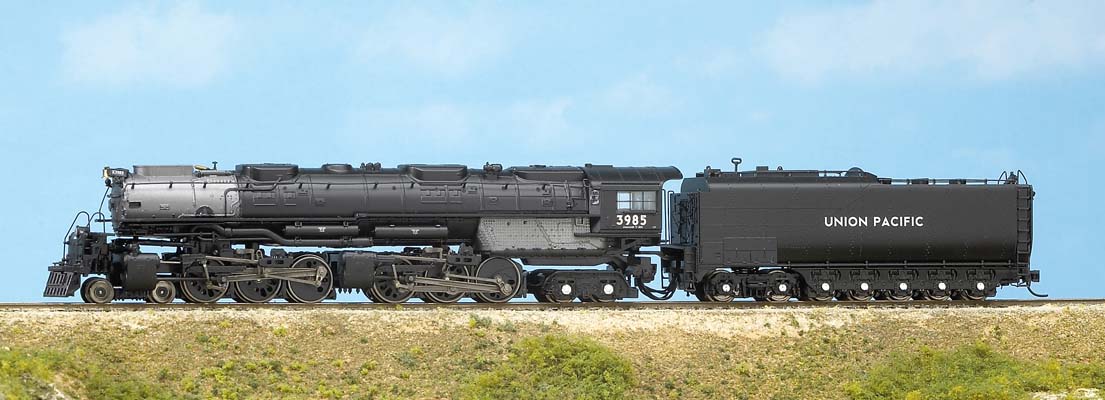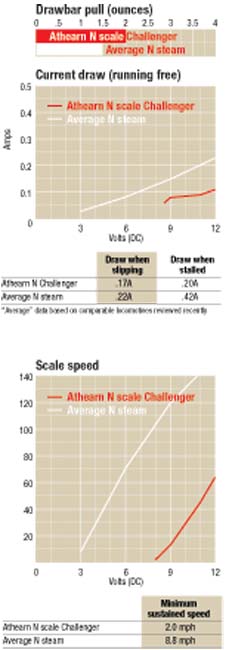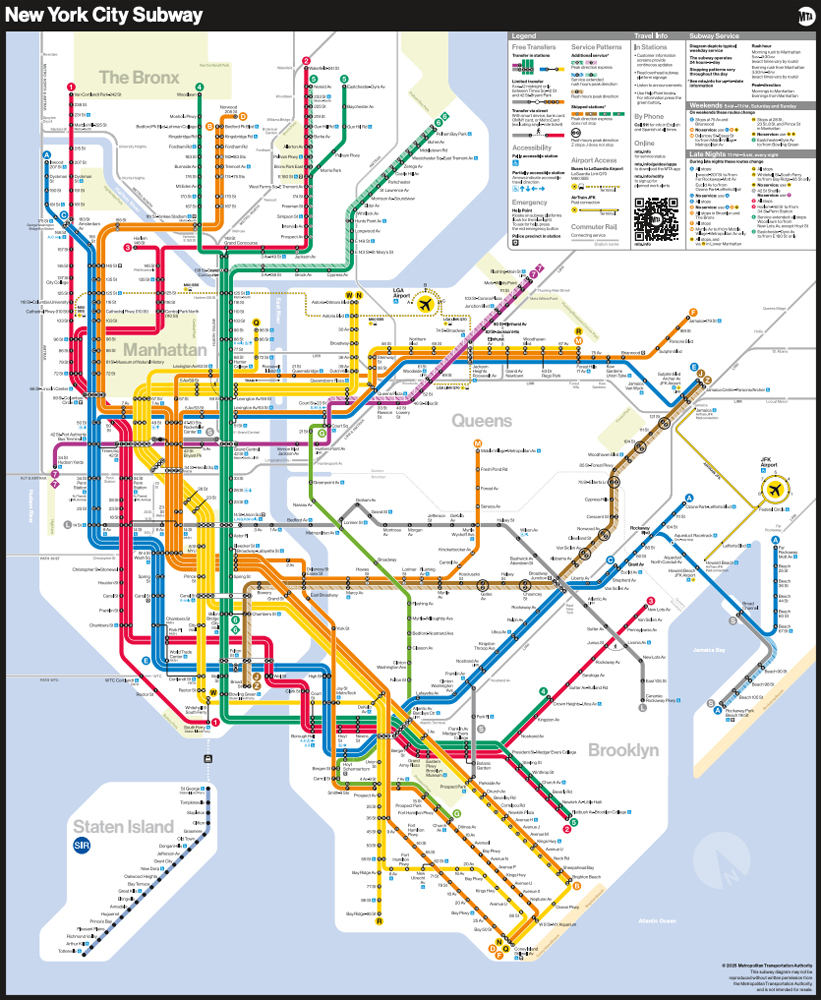N scale model’s pilot wheels are 34 scale inches in diameter instead of the 36″ of the prototype, and the drivers are 67 scale inches in diameter instead of 69″.
Our sample is decorated as the Union Pacific 3985 in her later excursion paint scheme. All lettering and decoration is crisp and straight and matches the prototype. Under magnification I could read the test stencil on the side of the model’s air reservoirs as well as AMERICAN on the Alco builder’s plates on the smokebox.
Separately applied details include handrails and a plated whistle and bell. Molded-in details, such as rivets and boiler bands, match prototype photos.
The tender correctly includes an oil bunker with modern safety appliances that were added after the year 2000. Number 3985 was converted to burn oil in 1990.
The model has the correct fully enclosed all-weather cab with front, rear, and side window glazing. The interior has no figures, but the backhead does have gauges and other detailing.
The pilot has a swing-out coupler pocket so that you can attach the included front knuckle coupler that mounts at the correct height per National Model Railroad Association standard S-2.
The model has the correct twin smokestacks of the prototype, but a noticeable black Phillips screw is used inside the front stack to attach the boiler to the chassis.
The prototype’s smokebox has a shield-shaped number plate, but unlike the prototype the shield on the model is blank.
The engine and tender are con-nected by a permanent drawbar and wires. As noted in the instructions, disassembly of this locomotive by the user isn’t recommended.
The blackened metal cranks and rods are realistic. The eccentric cranks are also oriented in the proper direction so that they lean forward when the main rods are in the bottom center position.
On prototype Challengers, only the front engine swivels. On the model the rear engine also swivels, allowing it to negotiate a curve with a radius as tight as 11″. I ran the Challenger around an 11″-radius oval of Kato Unitrack, but the cab swung out severely. The model looked more realistic when I ran it through a 161/4″-radius curve of Atlas code 55 track. It would look even better on 20″- (or greater) radius curves.
The Challenger didn’t derail through a code 55 no. 6 turnout, and its sounds remained continuous.
Although we didn’t encounter this problem, some modelers have reported that the Challenger’s non-driver wheelsets hit the ties on some code 55 track. Athearn will, at no charge, exchange these wheelsets for ones with smaller flanges.
In DCC, we tested the Challenger with a 12-volt power supply as specified in the instructions. Using 128 speed steps (the model also supports 14 and 28 steps), the model crawled in step 4 at 3 scale miles per hour. Our sample reached its top speed of 79 mph in step 128.
Most DCC systems run at 14 to 18 volts, so we also tested the Challenger with a 16-volt power supply, but its speed control performance was drastically reduced. On higher voltage systems, using an MRC Universal Voltage Reducer is strongly recommended.
Along with the whistle and bell, other sound effects controlled by the handheld remote controller include the sound of the water injector and the conductor yelling “All aboard!” Using the remote you can program some sound effects, including the whistle type. These range from a deep steamboat-style whistle to a high-pitched single-chime whistle to a few other options in between.
The whistle is the weakest sound effect of the model. It has a synthesized quality as well as an artificial-sounding echo effect.
The engine’s exhaust rate is adjustable in DC or DCC, but the model came programmed with the correct four chuffs per wheel revolution, and the sound was synchronized with each engine.
In DCC, most of the model’s sound and performance features are programmable. A configuration variable (CV) table is included in a 16-page instruction manual.
The overall sound quality is impressive for a 1:160 model. The speaker is well-enclosed without any distracting buzzes or rattles.
With its high level of detail and onboard sound, the model brings a new level of realism to N scale.
Price: $424.98
Manufacturer
Athearn Inc.
1550 Glenn Curtiss St.
Carson, CA 90746
www.athearn.com
Description: ready-to-run plastic steam locomotive
Road names: Clinchfield (single stack) nos. 670 and 672, and undecorated; Denver & Rio Grande Western nos. 3802 and 3804; Union Pacific no. 3943 (coal tender and smoke deflectors); no. 3958 (coal tender); no. 3964 (coal tender); no. 3975 (two-tone gray and oil tender); no. 3977 (two-tone gray and oil tender); no. 3983 (two-tone gray with oil tender); no. 3985 (fan trip version with modern oil tender); undecorated (UP/Rio Grande version or late UP version)
Constant directional headlight and backup light
Drawbar pull: 2 ounces
Dual flywheel drive
Dual mode Digital Command Control (DCC) sound decoder
Electrical pickup on eight drivers and eight tender wheels
Engine and tender weight:
7 ounces
Five-pole skew-wound motor
Micro-Trains knuckle coupler on the rear of the tender (mounted at correct height)
Minimum radius: 11″ (15″ or greater recommended)














